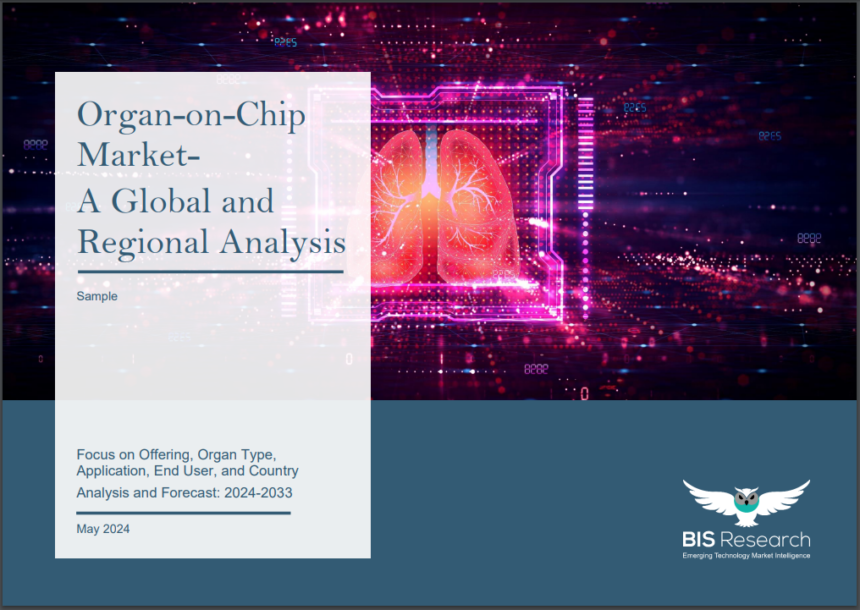 The advent of organ-on-chip (OOC) technology has disrupted biomedical research, offering never-before-imagined opportunities to study human organ systems in vitro with remarkable accuracy.
The advent of organ-on-chip (OOC) technology has disrupted biomedical research, offering never-before-imagined opportunities to study human organ systems in vitro with remarkable accuracy.
According to BIS Research, the global organ-on-chip market is projected to reach $3,596.3 million by 2033 from $109.9 million in 2023, growing at a CAGR of 42.09% during the forecast period 2024-2033.
These microfluidic devices, which simulate the physiological responses of human organs, have the potential to replace traditional cell cultures and animal testing, leading to faster, more reliable drug development and personalized medicine.
However, the development of miniaturized organ models presents several challenges that must be overcome to realize the full potential of organ-on-chip technology.
Reproducing Complex Organ Functions
One of the primary challenges in developing miniaturized organ models is replicating the complex functions of human organs. Human organs are intricate systems composed of multiple cell types, each performing specific roles in a highly coordinated manner. Mimicking this complexity on a chip requires precise control over cell placement, differentiation, and interaction.
Advances in stem cell technology and 3D bioprinting have been instrumental in addressing this challenge, allowing for the creation of heterogeneous tissues that more closely resemble those found in the human body.
Stem cells, mainly induced pluripotent stem cells (iPSCs), can differentiate into any cell type, making them ideal for creating diverse cell populations within organ models. 3D bioprinting technology, on the other hand, enables the construction of intricate tissue architectures by depositing cells layer by layer in precise patterns.
Together, these technologies have made significant strides in reproducing the cellular diversity and spatial organization of human organs.
Placenta-on-a-Chip Model
Nicole Hashemi, a mechanical engineer at Iowa State University, developed a placenta-on-a-chip to model the placenta and understand how substances like caffeine move through it during pregnancy.
This innovation uses microfluidic technology to simulate fluid movement across the placenta, providing insights into the impact of drugs and toxins.
The placenta-on-a-chip, made of silicone with microchannels, mimics maternal and fetal blood flow, allowing researchers to study the effects of substances on the fetal side. Supported by a $350,000 NSF grant, this model could evolve pregnancy studies, predicting the impact of unknown drugs and toxins and tailoring treatment options.
Integrating Mechanical and Biochemical Cues
Another major challenge is integrating the mechanical and biochemical cues that are crucial for organ function. Human organs are subjected to various physical forces, such as shear stress from blood flow in the liver or cyclic stretching in the lungs.
These mechanical cues are essential for maintaining tissue homeostasis and function. Moreover, organs are exposed to a complex array of biochemical signals, including hormones, cytokines, and growth factors, which regulate cellular behavior.
To address this challenge, researchers have developed microfluidic systems that can recreate the dynamic environments of human organs. These systems use fluid flow to mimic blood circulation, allowing for the continuous delivery of nutrients and removal of waste products.
They can also apply mechanical forces, such as stretching or compression, to cells cultured within the chip. By incorporating these physical and biochemical cues, organ-on-chip devices can more accurately replicate the in vivo conditions of human organs.
NIST to Test Drugs
NIST is leading a working group to develop standards for organ-on-a-chip research, which involves creating microfluidic devices that mimic human organs to test drugs. These devices provide a controlled environment to study tissue reactions, offering an alternative to in vitro and in vivo testing.
The group, consisting of global researchers from industry, academia, and government, aims to standardize protocols, measurements, and terminology to enhance the field’s progress. The initial focus areas are the heart, kidney, and liver.
A workshop at Michigan State University in April 2023 helped gather input from stakeholders. NIST’s neutrality facilitates collaboration and the development of these standards.
Silk-Based Membranes Are Enhancing Disease Research Accuracy
Biomedical engineers at Duke University have developed a new silk-based ultrathin membrane for organ-on-a-chip (OOC) platforms that better mimics human extracellular membranes, enhancing disease research accuracy.
Traditional polymer membranes are thicker and limit cell communication and growth, whereas the new silk fibroin membrane is less than five microns thick, closely resembling natural extracellular matrices. This advancement allows cells to form more realistic tissue structures, improving disease modeling and therapeutic testing.
Applied to kidney chip models, the membrane facilitated cell differentiation and efficient molecule filtration, aiding kidney disease research and potential drug screening. The technology could enhance models for other organs, including the brain, liver, and lungs. The study was published in Science Advances.
Ensuring Physiological Relevance
Ensuring the physiological relevance of miniaturized organ models is another critical challenge. For organ-on-chip devices to be beneficial, they must faithfully replicate human organs’ physiological and pathological processes.
This requires not only recreating the cellular and mechanical environment but also accurately modeling the organ’s response to various stimuli, such as drugs or disease conditions.
One approach to enhancing physiological relevance is the use of patient-specific cells derived from iPSCs. These cells can be used to create personalized organ models that reflect the genetic and phenotypic characteristics of individual patients.
Such personalized models can provide valuable insights into patient-specific drug responses and disease mechanisms, paving the way for personalized medicine.
Moreover, researchers are increasingly focusing on developing multi-organ-on-chip systems that can simulate the interactions between different organs.
The human body is a highly interconnected system, and the function of one organ often depends on signals from others. Multi-organ systems can provide a more comprehensive understanding of how drugs or diseases affect the body as a whole, improving the predictive power of organ-on-chip technology.
Standardization and Scalability
Standardization and scalability are also significant challenges in organ-on-chip technology. For these devices to be widely adopted in research and industry, standardized protocols for their fabrication, operation, and validation are needed.
Currently, there is considerable variability in the design and fabrication of organ-on-chip devices, making it difficult to compare results across different studies and laboratories.
Efforts are underway to develop standardized guidelines and protocols for organ-on-chip technology. These include defining key performance metrics, such as barrier integrity, cell viability, and functional readouts, and establishing standardized materials and fabrication methods. Standardization will facilitate the reproducibility and comparability of results, accelerating the adoption of organ-on-chip technology.
Scalability is another critical issue, particularly for high-throughput screening applications. Traditional fabrication methods, such as soft lithography, are labor-intensive and not easily scalable. Emerging technologies, such as injection molding and automated microfluidic assembly, hold promise for producing organ-on-chip devices at scale. Moreover, integrating organ-on-chip platforms with automated imaging and data analysis systems can further enhance their utility for high-throughput applications.
Regulatory and Ethical Considerations
Finally, regulatory and ethical considerations must be addressed to ensure the successful translation of organ-on-chip technology into clinical and industrial settings.
Regulatory agencies, such as the FDA, need to establish clear guidelines for the validation and use of organ-on-chip devices in drug development and safety testing. These guidelines should address issues related to the reproducibility, reliability, and predictive value of organ-on-chip models.
Ethical considerations also play a crucial role, particularly in the use of human-derived cells and tissues. Ensuring informed consent and protecting donor privacy are essential for the ethical use of patient-specific cells. Moreover, the development and use of organ-on-chip technology should be guided by principles of equity and accessibility, ensuring that the benefits of this technology are available to all.
Conclusion
By overcoming these challenges, researchers can pave the way for more accurate, reliable, and widely adopted organ-on-chip platforms.
Organ-on-chip technology will not only accelerate drug development and precision medicine but also reduce the reliance on animal testing, leading to more humane and effective biomedical research.
About the Publisher: BIS Research is a global market intelligence, research and advisory company that focuses on emerging technology trends that are likely to disrupt the market. Its team includes industry veterans, experts, and analysts with diverse backgrounds in consulting, investment banking, government, and academia.








